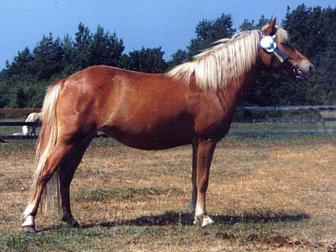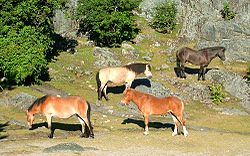|
Home Horse Breeds | First Posted June 29, 2009 May 13, 2020 | |
Gotland, Russ or Skogsruss PonyWild or Feral Horse  
The Gotland is believed to descend from the pre-historic horses which migrated west from the plains of Asia. The breed, as we know it, is indigenous to the island of Gotland in the Baltic Sea off the Swedish coast. In the 1800s Oriental blood was introduced to the original breed. Overview One of the oldest breeds of equids in Europe is the Gotland Pony. Known also as the Russ or Skogsruss, this pony has lived on the island of Gotland off the Swedish coast since the Ice Age. These ponies have historically lived in the outdoors year-round, enduring an often harsh climate of rain and snow. The Gotland has been used by mainland Swedish farmers, yet this pony's abilities also lead to its use by children as a saddle horse and in harness racing. Like many ponies throughout the rest of Scandinavia and northern Britain, it is believed the Gotland is descended from the original wild horses of Asia. In the 1800s, Persian and Arab blood were added to the breed with excellent results. This breed of horse resembles the Hucul and Konik of Poland. Physical Description The Gotland Pony stands 12 to 12.2 hands. The coat of the Gotland pony can be a variety of colors, although bay or black is usually preferred. Wild bay and mealy (Pangare) are very common in the breed. Common colors include bay, chestnut, black, buckskin, and palomino, but all colors except for dun, grey, and dorsal pinto, are allowed. It has a small head with a broad face and large, expressive eyes. The ears are small and pricked, and the neck is short. The back is long, and the withers pronounced and the croup is sloped. Its short legs are strong and clean with little cannon bone. The Gotland is noted for its endurance and occasional stubbornness. It has an excellent trot but does not gallop well. Interesting Facts: Until recently, with the coming of mechanization, the Gotland pony was extensively used by Swedish farmers for light draft work. Its relatively great strength and endurance adapted it to such work. At this time, there remains a herd of non-domesticated Gotland ponies. They live on the island of Gotland in the Baltic Sea off the Swedish coast in a forest at Lojsta. Influences: 1. Mongolian Wild Horse 2. Asiatic Wild Horse 3. Tarpan For More Information:
Sources:
Permission given by my dear friend, Cowboy Frank, to use his breeds section. |